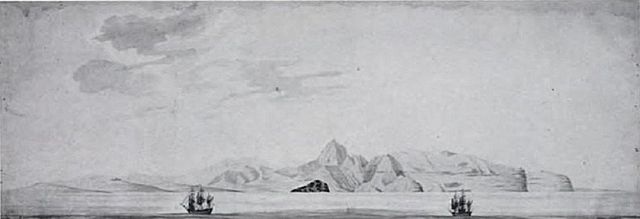Within ten years after Captain Cook’s 1778 contact with Hawai‘i, the islands became a favorite port of call in the trade with China. The fur traders and merchant ships crossing the Pacific needed to replenish food supplies and water.
The maritime fur trade focused on acquiring furs of sea otters, seals and other animals from the Pacific Northwest Coast and Alaska. The furs were mostly sold in China in exchange for tea, silks, porcelain and other Chinese goods, which were then sold in Europe and the United States.
Needing supplies in their journey, the traders soon realized they could economically barter for provisions in Hawai‘i; for instance any type of iron, a common nail, chisel or knife could fetch far more fresh fruit meat and water than a large sum of money would in other ports.
A triangular trade network emerged linking the Pacific Northwest coast, China and the Hawaiian Islands to Britain and the United States (especially New England).
Foreign vessels had long recognized the ability of the Hawaiian Islands to provision their ships with food (meat and vegetables,) water, salt and firewood.
Salt was Hawaiʻi’s first export, carried by some of the early ships in the fur trade back to the Pacific Northwest for curing furs. Another early market was provided by the Russian settlements in Alaska.
On January 21, 1821, the Thaddeus (the brig that carried the Pioneer Company from Boston to Hawai‘i) was sold to Liholiho (Kamehameha II). Liholiho put her into service in the Northwest trade. On July 12, 1821, William Sumner sailed the Thaddeus to Maui to gather a load of salt to trade for goods at Kamchatka. (Mills)
In Kamchatka, “Salt is at present issued, but not in sufficient quantities; were that article more liberally distributed, the people might in some years prepare fish to last them several successive ones.”
“From the quantity now supplied by the king of the Sandwich islands, it is to be hoped that the first productive season will be taken advantage of.” (Cochrane)
“The principal riches of Kamtchatka may be said to consist in the animals of the chase, of which there are so prodigious a number, that there are not sufficient inhabitants to take them. The most valuable are foxes of various colours, a few sea and more river otters, with an immense number of sables.”
“Bears, wolves rein-deer and mountain-sheep, and sometimes a few lynxes, are also to be found. The number of skins annually exported and consumed in the peninsula is about thirty thousand, of which sables and foxes form the principal part.” (Cochrane)
On behalf of the Hawaiian government Alexander Adams “brought home a couple of deer the last time with a view of their thriving in the islands, but they had not long been suffered to go at large in Hanarura valley …”
“… when Pitt [Kalanimōku] happening to be unwell, fancied that the flesh of the deer would do him good, and one of them was killed for him to taste. This he found so much to his liking that he ordered the other one to be killed, thus ending the life of poor Adams’ deer.” (Macrae)
“Deer were not the only kind of wild animals introduced into Honolulu during the reign of Liholiho. [T]hat monarch dispatched his American-built brig, the Sunbeam [likely the Thaddeus], commanded by an Englishman, Captain John Bowles, and manned by Sandwich Islanders …”
“… to St. Peter and St. Pauls (Petropaulovski), Kamtschatka, with a cargo of salt as a present to his imperial brother, the Czar of Russia.”
“In return for this gift on the part of the Sandwich Islands king, the governor of St. Peter and St. Paul’s, who was then Captain Ricord, an Englishman, gave such articles as seemed most desirable, including some animals, with a view of propagating the breed.” (Macrae, footnote)
“[T]he beautiful clipper entered the harbour of Peter and Paul in Kamchatka. She flew a flag which to the watchers on shore was absolutely unknown; blue, white, and brown.”
“She seemed to be full of men, and saluted the fort with seven guns. In those days Petropavlovsk was practically the only Russian port on the Pacific, for the Amur River belonged as yet to the Chinese, and Vladivostok was still a desert.”
“The arrival of any ship in that God-forsaken port was a rare and great event, much more that of a vessel so mysterious. The whole population – about three hundred souls – gathered on the foreshore.”
“All the authorities were there, with the Governor at their head. This was Captain Ricord, an English naval officer who, with numerous compatriots, was in the Russian service, and had received, after many adventures, the governorship of Kamchatka as a reward for his distinguished services. …”
“Captain John Bowles [was] commanding the clipper Sunbeam of His Majesty Kamehameha II, King of the Sandwich Islands. The Sunbeam’s cargo consisted of salt, intended by His Majesty as a present to the Emperor and Autocrat of all the Russias …”
“… in return for which His Majesty hoped that his ‘dear brother’ would send him animals fit to be bred in His Majesty’s islands – and especially bears!” (Poliakoff)
They made the trade and “Amongst the animals were two Siberian bears, but what became of them when landed at Honolulu is now forgotten.” (Macrae, footnote) (This summary was inspired and informed by Peter Mill’s recent book ‘Connecting the Kingdom;’ it’s a good read on sailing vessels in the early Hawaiian monarchy.)


















